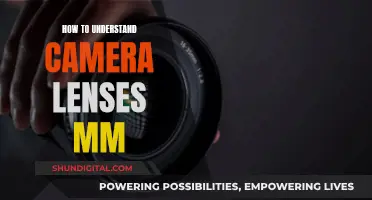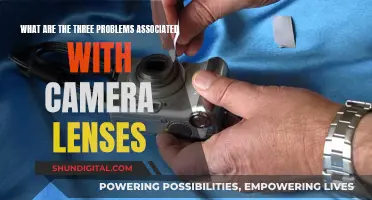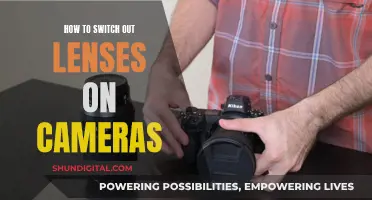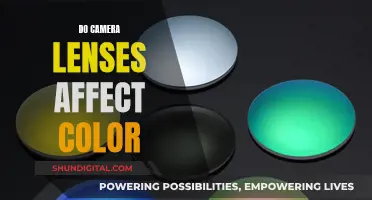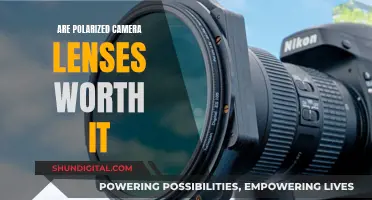
Packing camera lenses for travel or shipping can be stressful, especially when they are expensive. Proper packing is essential to ensure they arrive at their destination without damage. Here are some tips to help you pack your camera lenses safely.
What You'll Learn

Use a sturdy box
Using a sturdy box is essential when packing camera lenses for shipping. The box should be made of reinforced cardboard with a corrugated layer between its inner and outer surfaces, as this type of box offers the most protection against impact damage. You can obtain suitable boxes from your local post office or shipping services, or reuse any boxes you have on hand as long as they are not damaged or dented.
The box should be large enough to accommodate at least 1.5 to 2 inches of soft, pliable packing material on all six sides of the wrapped lens. Using a box that is too small or not providing enough packing material can lead to damage during shipment. Place the wrapped lens in the centre of the box, surrounded by packing material on all sides and on top, ensuring that the box is snug but not bulging. The lens should be completely immobilized and unable to move around inside the box.
When packing multiple lenses, wrap them separately and place them together in the centre of the box. Make sure there is enough packing material between the lenses and on all sides to prevent them from knocking into each other.
Before sealing the box, test it by shaking it gently to ensure that the lens is secure and does not shift or make any noise. Cover all seams of the box with packing tape, and double-tape the main closures on the bottom and top. It is also recommended to place a copy of the packing label inside the box, in case the outside label gets damaged during transit.
Lens Identification: Serial Numbers on Camera Lenses
You may want to see also

Bubble wrap each lens
Bubble wrap is a great way to protect your camera lenses from bumps and scrapes during travel. It's a convenient, effective, and reusable material for protecting your gear. Here's a step-by-step guide to ensure your lenses are well-protected:
- Start with a clean lens: Before wrapping, use a microfiber cloth to gently wipe any dust or smudges from the lens.
- Roll the lens in bubble wrap: Place the lens on a sheet of bubble wrap and start rolling. Aim for 2-3 layers of bubble wrap, or about 2-3 inches of padding. Secure the roll with tape to prevent unraveling.
- Tape the ends: Fold and tape both ends of the bubble wrap roll. This step is crucial to prevent the lens from sliding out of the wrap.
- Create a protective cocoon: Place the wrapped lens in the centre of your shipping box. Surround it with additional bubble wrap, crumpled newspaper, or other soft, pliable packing material. Ensure the box is well-padded on all sides.
- Pack it snugly: The box should close snugly, without bulging. The lens should not be able to move around inside the box. You should not have to force the lid closed.
- Avoid over-packing: While it's important to pack the box snugly, avoid over-packing to the point where you have to force the lid closed. There should be no bulging sides, and you should not be able to hear the lens sliding around if you shake the box gently.
- Use the right box size: The box should be roughly twice the size of your lens to allow for adequate padding. A box that is too large will not provide sufficient protection, and one that is too small will not offer enough room for padding.
By following these steps, you can ensure your camera lenses are well-protected during travel or shipping. Bubble wrap is an effective and affordable solution to safeguard your valuable photography equipment.
Understanding Camera Lenses: Power of Convergence and Divergence
You may want to see also

Pack the box correctly
Packing camera lenses for shipping can be a stressful task, especially given their fragility and value. Here are some tips to ensure your camera lenses are packed correctly and safely:
Use the Right Box
Select a sturdy box made of reinforced cardboard with a corrugated layer between the inner and outer surfaces. The box should be roughly twice the size of the lens to allow for ample packing material. Avoid using a box that is too big, as this will leave too much room for the lens to shift during transit. Reusing old boxes is fine, but make sure they are not damaged or dented.
Wrap the Lens
Use bubble wrap to wrap the lens. Two to three layers of bubble wrap with small or medium-sized bubbles will provide excellent protection. Secure the bubble wrap with packing tape, and then tape or fold over the ends to prevent the lens from sliding out. If you have the original factory box or padded case for the lens, you can place the wrapped lens inside, providing an additional layer of protection.
Pack the Box
Line the bottom of the box with a layer of packing material, such as bubble wrap or clean rags. Place the wrapped lens in the centre of the box, ensuring it does not touch the sides. Pack more packing material around the lens and on top until the box is full and flush when the lid closes. The box should feel snug, and you should not be able to hear or feel the lens moving when you shake the box.
Seal and Label the Box
Seal all seams of the box securely with packing tape. Cover the label with clear tape to protect it from moisture and place a copy of the label inside the box. Add "Fragile" and "Signature Required" stickers to the outside of the box.
Choose a Reliable Shipping Service
Select a shipping service that you trust and that has a good reputation for handling fragile items. Consider using a service that includes tracking and insurance for valuable items. Bring the package to the shipper yourself and get a receipt as proof of shipment.
Understanding Crop Sensor Camera Lenses Focal Lengths
You may want to see also

Label the box
Labelling your box is a crucial step in the packing process. A clearly labelled box ensures that your package reaches the correct destination and helps handlers identify any special instructions. Here are some detailed steps to follow when labelling your box:
Firstly, create a label that includes all the necessary information. This should include the full addresses of both the sender and the receiver, including zip codes and country information if applicable. It is also good practice to include telephone numbers for both parties. Use a clear and legible font, such as a 22 or 24-point font size, and consider printing the label from a computer for clarity.
You can also add "Fragile" stickers or stamps to your box. The US Postal Service will happily stamp "Fragile" on your package, but the ink may rub off if applied directly to the box. Alternatively, you can create your own "Fragile, Handle with Care" stickers in large red type or purchase ready-made ones.
Once you have your label, attach it to a side of the box that has sufficient space. Use clear packing tape to secure the label, and then apply additional strips of tape over the label to protect it from moisture and damage. Ensure the tape extends beyond the sides of the box for maximum security.
If possible, place a copy of the label inside the box as well. This helps the shipping service identify the sender and receiver in case the box is severely damaged during transit.
Finally, before sealing the box, double-check that all the information on the label is correct. It is also a good idea to test the box by shaking it gently to ensure that the contents are secure and won't shift during transport.
By following these steps, you can be confident that your package will be properly labelled and ready for shipping.
The Intricate Art of Assembling Camera Lenses
You may want to see also

Add insurance and tracking
When shipping camera lenses, it is important to consider adding insurance to your package. This will provide financial protection in case the item is lost, stolen, or damaged during transit. The level of insurance coverage you need will depend on the value of your camera lens and other equipment.
Basic insurance coverage is often included with your shipping carrier. For example, USPS Priority Mail includes $50 worth of insurance, while Express and Expedited shipping typically includes $100 of free insurance. However, this may not be sufficient for expensive camera equipment. In that case, you can purchase additional insurance coverage. The cost of this additional insurance will depend on the value of your equipment, with higher-value items requiring a higher premium.
When purchasing insurance, carefully review the terms and conditions, including any deductibles, exclusions, and claim procedures. Keep in mind that collecting insurance on items damaged in shipment can be challenging, especially if the outer box appears undamaged.
In addition to insurance, consider adding tracking to your package. Tracking will allow you to follow the shipment's progress and confirm delivery. This service is often included with many shipping carriers, but it may be offered as an add-on for a small fee. Tracking can provide peace of mind and help you locate your package in case of any delivery issues.
By adding insurance and tracking to your shipment, you can have added confidence that your camera lenses will be protected during transit, and you will be able to locate them at every step of the journey.
The Ultimate Guide to Understanding Camera Lenses Variety
You may want to see also
Frequently asked questions
It is recommended to use a sturdy box with a corrugated layer, 1.5-2 inches bigger than your lens on all sides to provide maximum impact protection. Wrap your lens in 2-3 layers of bubble wrap and place it in the centre of the box, surrounded by packing material such as foam rubber, Styrofoam peanuts or crumpled newspaper. Make sure the box doesn't bulge but is snug enough that the lens doesn't move around.
Wrap each lens separately and place them together in the centre of the box.
Avoid packing peanuts, air pocket packets, thin bubble wrap, newspaper or packing paper. These materials do not provide enough protection for heavy items like lenses and cameras.
It is recommended to add "Signature Required" to any parcel containing camera equipment. This will ensure that the parcel is not left unattended on your doorstep. You should also consider insuring your equipment, as well as including tracking and "Fragile" stickers.


